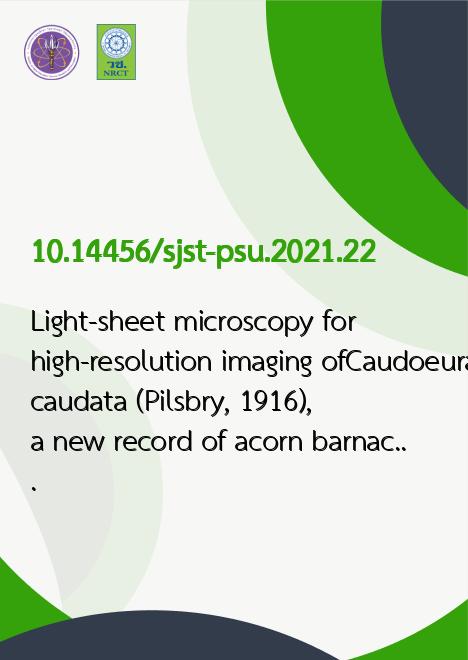
|
Light-sheet microscopy for high-resolution imaging ofCaudoeuraphia caudata (Pilsbry, 1916), a new record of acorn barnaclefrom Thailand's coast and its application in taxonomic identificationand micro-morphological studies |
|---|---|
| รหัสดีโอไอ | |
| Creator | 1. Woranop Sukparangsi 2. Chinnakit Wongkunanusorn 3. Pisit Sanjan 4. Sutin Kingtong 5. Salinee Khachonpisitsak |
| Title | Light-sheet microscopy for high-resolution imaging ofCaudoeuraphia caudata (Pilsbry, 1916), a new record of acorn barnaclefrom Thailand's coast and its application in taxonomic identificationand micro-morphological studies |
| Publisher | Research and Development Office, Prince of Songkla University |
| Publication Year | 2564 |
| Journal Title | Songklanakarin Journal of Science and Technology (SJST) |
| Journal Vol. | 43 |
| Journal No. | 1 |
| Page no. | 169-180 |
| Keyword | light-sheet microscopy, barnacle, Cirripedia, Chthamalidae, Caudoeuraphia caudata |
| URL Website | https://rdo.psu.ac.th/sjstweb/index.php |
| ISSN | 0125-3395 |
| Abstract | The acorn barnacle (Cirripedia: Balanomorpha) is a sessile crustacean arthropod, distributing around the intertidal areasof tropical and temperate regions worldwide. Current practices for taxonomic identification are based on shell morphology andlight microscopy, together with the use of scanning electron microscopy for arthropodal characters, which the latter techniquerequires complicated procedures. Through the recent technology of confocal light-sheet microscopy, here we demonstrate a cleardescription of Caudoeuraphia caudata (Pilsbry, 1916), a new record of its presence in eastern Thailand. This type of microscopyenables the high acquisition of fluorescent imaging of a whole barnacle's body and arthropodal structures, including cirri andmouthpart imaging in three dimensions, with simple procedures for sample preparation and through harboring autofluorescenceof their own barnacle structures. Hence, this technology could potentially be an alternative way for identifying acorn barnacles atthe species-level and visualizing the diversity of these marine arthropods. |
